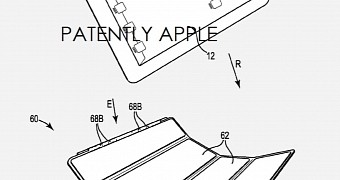How do you protect your iPad from drops? Currently, the best solution is either to get a bulky case with shock protection and pay a couple hundred dollars for it, or just make sure you don't drop it.
A new patent reveals how Apple is caring about protecting a gadget using some really forward-thinking ideas. According to patentlyapple, the new patent explains how the iPad Smart Cover and Smart Case can become truly smart and protect your device.
It's all in the magnets and sensors
The patent was revealed by a filing with the US Patent and Trademark Office, and it covers more than the case, but actual use scenarios for drop countermeasures.
The basic idea behind this new invention is that the iPad and electronic devices in general are prone to be affected by shock, compression and impact. The sensors inside the device may, however, improve those conditions and prevent damage. Although the patent drawings describe an iPad, the ideas are not limited to that device and they may apply to iPhone, laptops and other electronic devices as well.
The electronic device Apple is talking about has a housing that hides motion sensors and that may actually help when dropped. The countermeasure they have in mind may include "an actuator coupled to an actuated member, where the actuated member is operable by the actuator to modify the impact geometry." To put it in layman's terms, imagine that the iPad Smart Case or Smart Cover that is on the iPad can move quickly using its magnets to protect the side the device is about to fall on.
Apple explains that the device can use information from the proximity sensor, camera and motion sensor or accelerometer. The iPad Smart Cover may turn into an airbag-like device that may disconnect from the device and fall on the ground before the iPad. Thus, the iPad will have a softer landing.
If the iPad has a smart case on it (the kind that cannot easily detach), Apple engineers have found a way to use that as well. For example, the part that covers the screen will fold by itself and protect it. This can be realized by filling the case either with air or fluids that can be pressurized when needed.
With or without a case
When it comes to the iPhone, Apple engineers plan on using the gyro, accelerometer, and magnetic sensor to predict the impact geometry. Those, coupled with information coming from the cameras and the proximity sensors, will actually make the iPhone turn in the air when drooped so that it won't fall on its screen.
Bear in mind that this is just a patent and we may see this as an actual feature only after a few years. Nevertheless, it is an awesome way to protect your devices.

 14 DAY TRIAL //
14 DAY TRIAL //